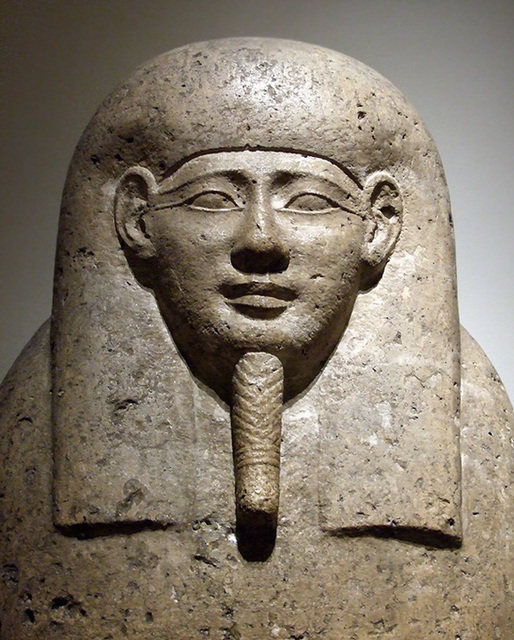Head of an Egyptian Official in the Brooklyn Museu…
Relief of a Nobleman in the Brooklyn Museum, Augus…
Enigmatic Relief in the Brooklyn Museum, August 20…
Stela of the Woman Takhenemet in the Brooklyn Muse…
Statuette of Hori in the Brooklyn Museum, August 2…
Egyptian Wood Stool with Latticework Bracing in th…
Stela of Two Deified Men in the Brooklyn Museum, A…
Animal Mummy & Sarcophagus in the Brooklyn Museum,…
Cat Mummy in the Brooklyn Museum, August 2007
Animal Mummies in the Brooklyn Museum, August 2007
Bust from an Enthroned Statue of Sakhmet in the Br…
Stele of Anhorkhawi in the Brooklyn Museum, August…
Face from a Coffin in the Brooklyn Museum, August…
Erotic Musicians Stone Figurine in the Brooklyn Mu…
Front View of the "Erotic Composition" Figurine in…
Back View of the "Erotic Composition" Figurine in…
Inner Cartonnage of Nespanetjerenpare in the Brook…
Detail of the Inner Cartonnage of Nespanetjerenpar…
Inner Cartonnage of Gautsheshenu in the Brooklyn M…
Detail of the Inner Cartonnage of Gautsheshenu in…
Canopic Chest in the Brooklyn Museum, August 2007
Canopic Chest in the Brooklyn Museum, August 2007
Canopic Chest in the Brooklyn Museum, August 2007
Lid of the Sarcophagus of Padiinpu in the Brooklyn…
Block Statue of Ay in the Brooklyn Museum, August…
Akhenaten and His Daughter Offering to the Aten Re…
Broad Collar in the Brooklyn Museum, August 2007
Senet Game in the Brooklyn Museum, August 2007
Egyptian Mask in the Brooklyn Museum, August 2007
Statue in a Niche in the Brooklyn Museum, August 2…
Egyptian Mask in the Brooklyn Museum, August 2007
Painting of a Standing King in the Brooklyn Museum…
Detail of Wishing Well in the Brooklyn Museum, Aug…
Wishing Well in the Brooklyn Museum, August 2007
Chest of Drawers in the Brooklyn Museum, August 20…
Detail of Fear and Denial by Osorio in the Brookly…
Detail of Fear and Denial by Osorio in the Brookly…
Fear and Denial by Osorio in the Brooklyn Museum,…
Fear and Denial by Osorio in the Brooklyn Museum,…
Coffin in the Form of a Nike Sneaker in the Brookl…
Coffin in the Form of a Nike Sneaker in the Brookl…
Coffin in the Form of a Nike Sneaker in the Brookl…
Farm Girl in the Brooklyn Museum, August 2007
Farm Girl in the Brooklyn Museum, August 2007
Skylight in the Brooklyn Museum, August 2007
Location
Lat, Lng:
You can copy the above to your favourite mapping app.
Address: unknown
You can copy the above to your favourite mapping app.
Address: unknown
See also...
Keywords
Authorizations, license
-
Visible by: Everyone -
All rights reserved
-
486 visits
Detail of the Lid of the Sarcophagus of Padiinpu in the Brooklyn Museum, August 2007


Lid of the Sarcophagus of Padiinpu
Limestone
Ptolemaic Period, 305-30 BC
From Hardai (Kynopolis)
Accession # 34.1222
Although anthropoid, or mummiform, coffins made of stone instead of wood first appeared during the New Kingdom (circa 1539-1070 BC), they did not become common until the Late Period (circa 664-332 BC). The change from wood to stone reflects a step toward permanent protection in the afterlife.
Padiinpu, the owner of this limestone sarcophagus, served as a scribe attached to the cult of the god Inpu (called Anubis by the Greeks) who was lord of the city of Hardai. He also served as a royal scribe and as a priest in a cult of the goddess Hathor. Padiinpu, who was named for the god Inpu, was the father of the owner of a similar lid displayed on the opposite side of the doorway.
Text from the Brooklyn Museum label.
Limestone
Ptolemaic Period, 305-30 BC
From Hardai (Kynopolis)
Accession # 34.1222
Although anthropoid, or mummiform, coffins made of stone instead of wood first appeared during the New Kingdom (circa 1539-1070 BC), they did not become common until the Late Period (circa 664-332 BC). The change from wood to stone reflects a step toward permanent protection in the afterlife.
Padiinpu, the owner of this limestone sarcophagus, served as a scribe attached to the cult of the god Inpu (called Anubis by the Greeks) who was lord of the city of Hardai. He also served as a royal scribe and as a priest in a cult of the goddess Hathor. Padiinpu, who was named for the god Inpu, was the father of the owner of a similar lid displayed on the opposite side of the doorway.
Text from the Brooklyn Museum label.
- Keyboard shortcuts:
Jump to top
RSS feed- Latest comments - Subscribe to the comment feeds of this photo
- ipernity © 2007-2025
- Help & Contact
|
Club news
|
About ipernity
|
History |
ipernity Club & Prices |
Guide of good conduct
Donate | Group guidelines | Privacy policy | Terms of use | Statutes | In memoria -
Facebook
Twitter

Sign-in to write a comment.